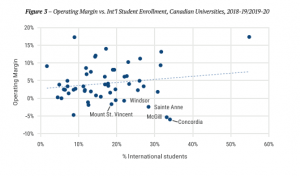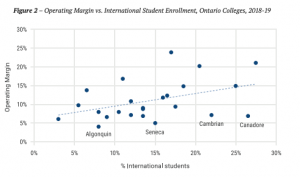A new report has identified Canadian universities and colleges that could be vulnerable to an “international student recession” caused by Covid-19, noting several institutions are already operating “in the red” despite having international student enrolment of 20% or higher.
News and business analysis for Professionals in International Education
Have some pie!
Report names Canadian HEIs most at risk from int’l student decline
 There are a number of institutions already operating in the red despite having international student enrolment of 20% or higher. Photo: Pexels
There are a number of institutions already operating in the red despite having international student enrolment of 20% or higher. Photo: Pexels Published by the Higher Education Strategy Associates, the ‘State of Postsecondary Education in Canada 2020’ report compares universities and colleges’ operating margins with their international student enrolment, and assesses which institutions are at most risk from a drop in international students.
“Instead of reducing the rate of spending growth, many of them chose to ramp up recruitment”
“We all know the basics of the story,” said HESA’s president Alex Usher in a blog post that accompanies the release of the report.
“In the aftermath of the 2008 financial crisis, Canadian governments stopped increasing their spending on postsecondary education, but universities and colleges didn’t stop wanting more money.
“Instead of reducing the rate of spending growth, many of them chose to ramp up the recruitment of high fee-paying international students.”
According to the report, the number of international students at the postsecondary level in Canada has risen dramatically from just under 40,000 in the late 1990s to over 340,000 in 2018-19.
In 2018-19, international students made up 15.7% of all university enrolments and 16% of all college enrolments.
“The point here is that yes, many institutions are highly reliant on international students. But many institutions were also socking away money in the months before Covid-19, which means they might be well-placed to survive a temporary financial hit.
“The institutions that are going to be hit hardest by Covid aren’t simply the ones that have a lot of international students – they are the ones with a lot of international students and weaker financial positions,” he said.
The report goes on to analyse which institutions are most at risk, looking at data for both universities and colleges. For universities, this data is more complete, with an extra year of international student figures available for most institutions.
It states that there are a number of institutions already operating in the red despite having international student enrolment of 20% or higher.
Concordia (QC), McGill, Sainte-Anne, Windsor and Mount Saint Vincent, are all highlighted by the report as being most at risk.
“Of these, McGill’s prestige means it is least likely to see a big fall in international student numbers, but at Sainte-Anne, Mount St. Vincent and Windsor in particular, the trifecta of lower prestige, weak finances and high dependence on international students means the next few months may be a time of high anxiety,” the report explains.
The public data available for colleges data on international student enrolment is far more limited and so the report only considers the question of colleges in Ontario.
According to the report, this is still useful “since no part of the Canadian post-secondary sector is as dependent on international students as Ontario colleges”.
In a graph, the authors of the report position each Ontario college with respect to both its operating margin (excess of revenues over expenditures) and the percentage of its student body which is comprised of international students.
The report notes that institutions’ operating margins are positively correlated with international enrolment and that overall margins are fairly high, indicating that most institutions are probably in a position to ride out one or perhaps even two semesters of reduced international enrolments.
However, the data also shows that there are a number of institutions – in particular Canadore, Cambrian and Seneca, which have relatively high levels of international student enrolment, but which – in 2018-19 at least – also have relatively low levels of operating margins.
“These, therefore are the three institutions one might obviously expect to be most at risk from a loss of international students,” the report said.
“The ongoing pandemic certainly raises financial concerns”
A recent report from CBC News said that Cape Breton University is dealing with a $16M revenue loss due to Covid-19, and that the school is now running a $6M deficit.
A spokesperson for Concordia told The PIE News that the university eliminated its deficit in 2018-19, one year earlier than anticipated, and presented a balanced budget for 2019-20.
“The ongoing pandemic certainly raises financial concerns, as it does with all institutions,” they said.
“Right now, the trends in overall enrolment indicate similar numbers to fall 2019 but there are of course uncertainties related to costs during the pandemic and loss in revenue, particularly from non-thesis master international students as well as from income generated by hosting events and other activities that cannot take place at this time.
“We remain committed to taking actions and articulating a budget framework that best ensures our long-term financial sustainability,” they added.
A spokesperson from Mount Saint Vincent University told The PIE that although HESA should be commended for undertaking such an important and grand research project, it’s difficult to fully understand the context in which institutions are operating.
“MSVU is not operating in the red, rather the university is in strong financial shape,” the spokesperson said.
“With regards to our percentage of international students, we are not more reliant on international students than many other universities; in fact, where we do stand out (and what is not reflected in the data) is that we’ve been successful in our efforts to ensure diversity of our international student population.
“Overall, our enrolments have remained quite strong in spite of the pandemic,” they added.
A spokesperson for Cambrian College, said that the institution has taken a “very prudent, conservative approach to financial stewardship”, and that it has produced balanced budgets for the last 10 years in a row (as indicated by audited financial statements posted on the college’s website).
“This approach to budgeting began well before our process of increasing our international enrolment,” the spokesperson said.
“This approach to budgeting began well before our process of increasing our international enrolment. We have been able to achieve balanced budgets by consistently spending within our means and planning for modest and measured growth, to avoid becoming dependent upon wild swings in enrolment, domestic or international,” they added.
Still looking? Find by category:





If this is the situation, then why not they ease down the rules of study visa permit. First, they also want that student should come and study there so that they can generate revenew, on the other hand they reject the visas very easily based on some silly reason, which is really dishartening to so many students and quite an irony. They should ease down visa rules to attract more students. The whole process of immigration to canada is the most difficult one for the international students. The situation which is mentioned in the article is bound to happen if visa rules are not easing down.
Well said
Completely agree to what Jaya has said in her comments.
Sorry not Jaya but Jiya..
Soon Canada should announce students to come without IELTS. Same strategy was used by UK in 2008-2009 During recession time.
Absolutely agree to what Jiya has said. I feel there is a huge gap in communication between the immigration officers and the reality in Canada. It feels more like they are just advertising to the world that they need more people when what they actually want are funds generated from more applications. They don’t give a damn about what troubles these applicants go through to pay for these processes and how they put their life on hold with hope to getting through. It would at least help if the system could at least be transparent enough to provide a reply within a few days of applying rather than months and in some cases even years!!
Yeah , I agree with my friend , it is absolutely insane !! How can international students paid nonrefundable tuition fees and yet still the embassy continue to refuse the student without any tangible reason, upon providing all the required documents to the embassy they still refused students. In fact the Canadian embassy refuses student visa for just fun. They don’t care about the nonrefundable tuition the student has paid, they don’t care about the documents the student has provided. All what they do is that they refused students visa for fun.
we’ve not been successful in our efforts to ensure diversity of our international student population.
80% of student are from India. This is not the right thing.
Where is the info on western Canadian universities? If one is looking at the global impact of a decline in international students the study should offer perspective that reveals the extent of the issue across Canada and not just focus on eastern Canadian institutions.
Totally agree with Jiya! My wife had student visa refused for unbelievably reasons! They said we don’t have money enough in the first applying, but we have more than 3 times of IRCC requirement! Then we tried a second application, explaining better the money situation, and them refused because they don’t believe we will return to the country were we live today, AND the program my wife has chosen is nothing to do with her professional and academic background (but the program is totally in the same field!) First of all, who is the officer that can decide if a program fits for someone or not? The university itself has accepted the student, who is the officer to say that the program is not for this student? Insane! I can’t believe they use the justification that a student will not go back to her/his country if there are hundreds of immigration program to keep people living there in Canada. It’s totally hipocrate! How do they want more qualified immigrants if they don’t allow students to get in the country for ridiculous reasons? Joke!